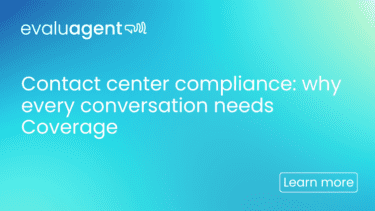Contact Centre Compliance: Why Every Conversation Needs Coverage


As contact centres, we are a hotbed of high-risk compliance activity and are tasked with balancing complex and contradicting requirements:
75% of contact centres agree that compliance is a top priority. Yet, when faced with shaky compliance processes, many fall short of proactive intervention. And it’s no wonder. Without the right tools, compliance auditing can be painfully slow and inefficient. It takes the average contact centre 37 hours to provide auditors with requested data, and on average, they only review compliance every 47 days.
So, although most organisations are at least using some sort of system or software to manage regulatory compliance, a costly mistake can easily slip through.
Case study: When a single conversation costs £100,000
Every conversation counts, but some are worth more than others. When Joyce transferred £100,000 to a scam investment, her bank failed to ask her critical safety questions. The ombudsman later stepped in and found the bank fully liable for Joyce’s losses.
Is that a cautionary tale or a common pitfall? Well, in 2020 alone, some of the biggest names in banking were fined millions for compliance breaches:
And compliance breaches are only getting more expensive. In 2021, the average cost of a data breach rose from $3.86 million to $4.24 million.
Compliance continues to tighten across many industries, mainly as financial regulators are working harder than ever to protect vulnerable customers through this period of economic downturn.
Each industry faces unique regulatory challenges, but, across all sectors, contact centres shoulder significant responsibility for risk management.
The value of human to human interactions can’t be denied, but they carry an unavoidable risk of human error.
Many contact centres have no idea of the risks their agents are taking (or how successfully). The coverage simply isn’t there. Traditional QA monitors less than 3% of conversations, which are cherry-picked for evaluation. It’s a wafer-thin approach that does little to manage compliance risks.
In the context of ever-increasing regulatory compliance, anything less than statistically significant coverage opens the door to costly mistakes.
Most compliance breaches result from issues, such as:
… All of which can be addressed by QA that connects increased coverage and insights with better agent training.
The problem: Traditional QA and auto-QA don’t quite cut it
QA is the only way to know what’s going on in the thousands of daily conversations between agents and customers. But all QA is not made equal – the details differ as much as its varied users.
Traditional QA can be time-consuming (especially if you’re using spreadsheets or clunky software) and fails to yield robust data, coverage, and confidence that risk is being managed. You’re monitoring only the tip of the iceberg, leaving you exposed to vast unknowns.
Auto or AI-based QA is touted as “The Answer”. Unfortunately, that’s not quite the truth. While auto-QA uses analytics to monitor and score 100% of contacts, it doesn’t provide you with real actionable insight to drive improvement – not on its own, anyway.
In either case, traditional QA and auto-QA are both vulnerable to the biggest compliance pitfall: Measuring the wrong things, in the wrong way, at the wrong time.
Is there a smarter way to do QA that combines the best of traditional and auto-QA? That helps contact centres better manage risk without breaking the bank?
Yes, and we call it Smart Quality!
How to start optimising your QA to reduce compliance-related risk
Smart Quality is our brand new approach to QA. It’s designed to connect insight and improvement and empower your team with all the tools they need to thrive. Reducing compliance-related risk is just one benefit of optimising your QA, along with reducing costs and increasing customer satisfaction.
So, how does it work?
You need the right tools for the job. Are you using spreadsheets or clunky on-premise QM modules that got bundled with your call-recording system? If so, it’s time for a rethink.
You’ll want a QA system that can provide statistically significant coverage and give you the ability to measure the right things. What’s ‘right’ differs for every contact centre, but this article can be a useful guide rope to building your scorecard.
The other things you need to look for in your QA system are:
How does this help you manage your compliance risks? Never forget that your results are delivered by people. The tools you provide need to work for them; tools that respect their time, make their jobs easier and reduce the scope for human error while retaining autonomy.
The next step is building and testing automatic customer experience and compliance scores that mean something to agents and team leaders. We recommend making your QA operations a team effort. Remember, benefits are delivered by agents – disengage them in the process, and you’re lost.
When assessing your data, you need to adopt a risk-based approach that auto-flags priority areas to be the focus of traditional, manual evaluation. There is no replacement for humans when it comes to understanding nuance, context and problem-solving.
At this stage, your agents are flourishing, you are evaluating conversations to shape feedback, and you’re continuing to train your analytic outputs and deliver value. The final push is to make your ship watertight and scale your coverage up to 100%.
With this cultural shift (recognising QA as mission-critical), you’ll have the tools and mindset to deliver the right balance of customer needs, business expectations and compliance with regulatory requirements.

